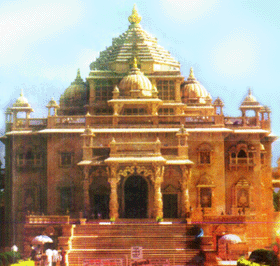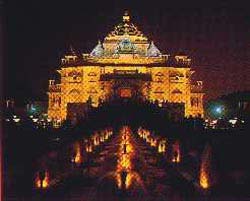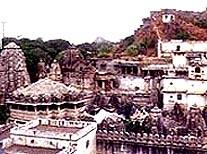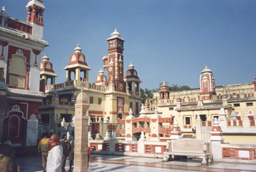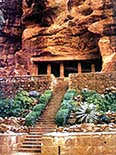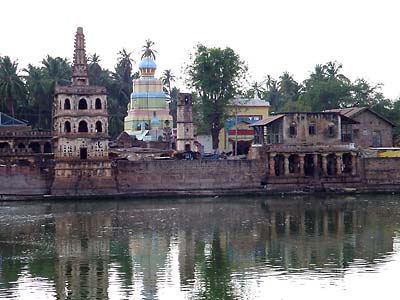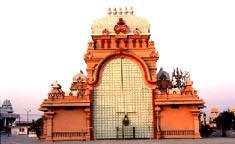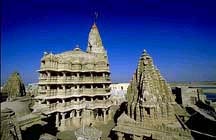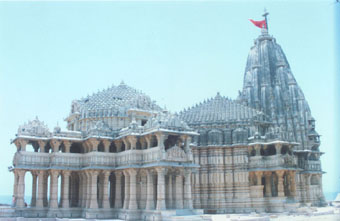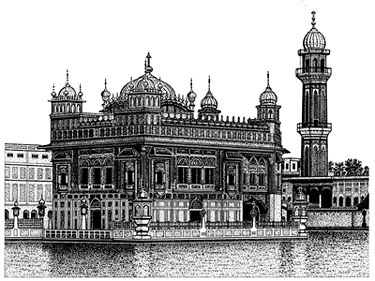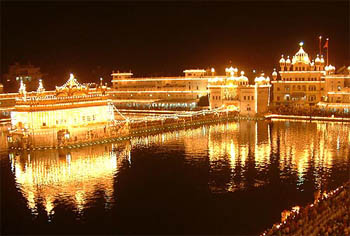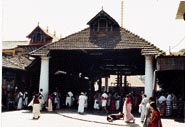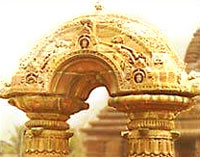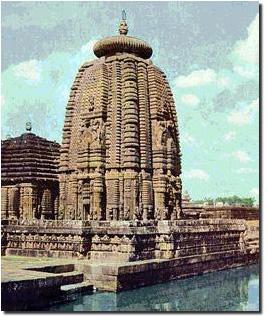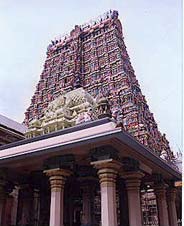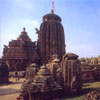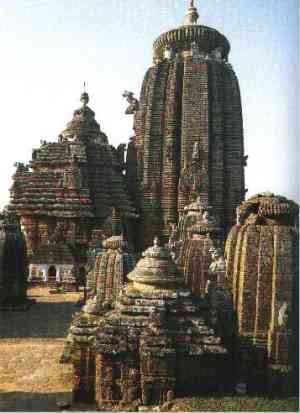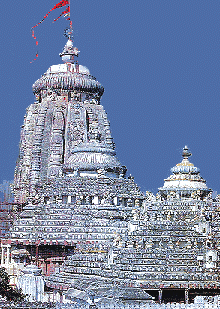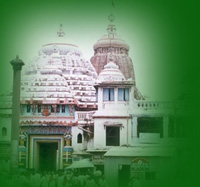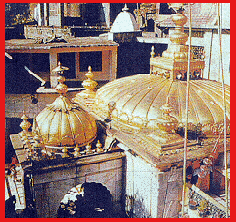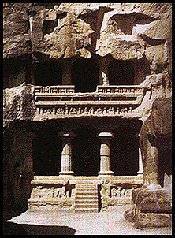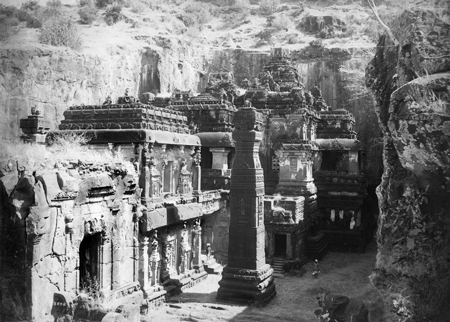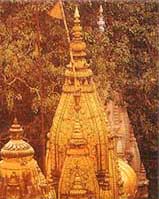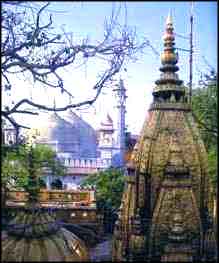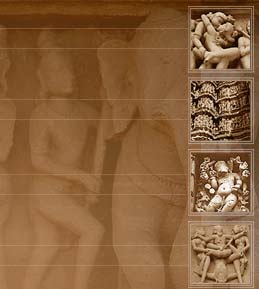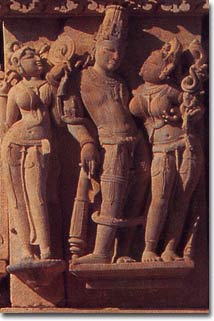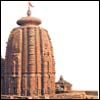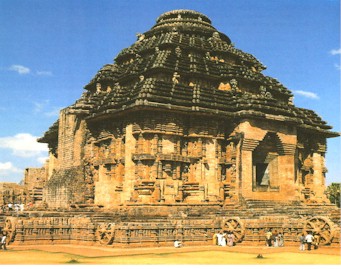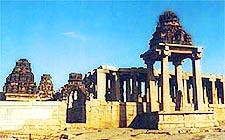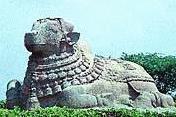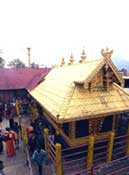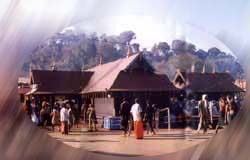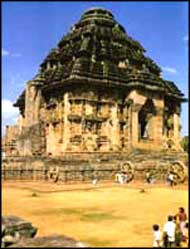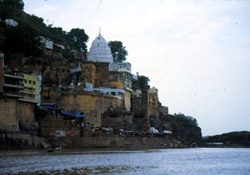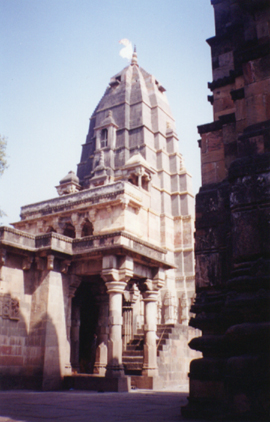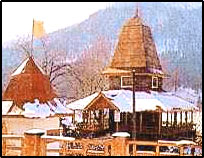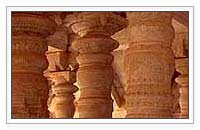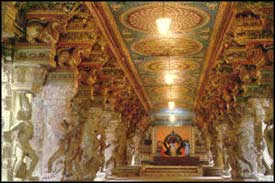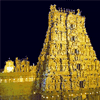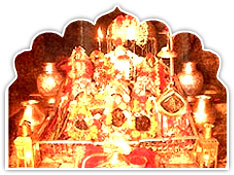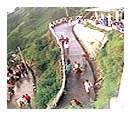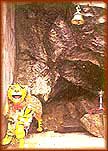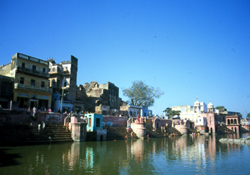 |
||||||||||||||
|
|
||||||||||||||
HinduOfUniverseHindu Temples
India, historically referred to the territory bound by the Hindu Kush and the Himalayas, is a country full of wonderful temples. These unmatched and artistic architectures contribute richly to the Indian cultural heritage. Temples are found everywhere in India, in villages and in towns. The earliest temples are the rock cut and cave temples in India. Ancient era was the witness when religious practices flourished the most and temples became the world's storehouse of knowledge and culture.. The ancient temples are more than mere places of worship. These are sacred buildings of ultimate grace and eternal hapiness. The temples of the Medieval Era were varied architectural styles. The temples and the religious places built then were symbolic of the ruler and his richness and devotion. The seeds of experimentation in religious architecture were sown in medeival temples. India has many splendid temples that have found a place in World Heritage list. These temples are cynosure of all for their marvellous architecture. These pronounce the age old customs and traditions of India. These include Sun Temple at Konark, Khajuraho Temples, Ajanta Caves, Brihadeswara Temple, and Sanchi Stupas. Here is a detailed discussion on the history, and stylistics of some of the great temples of India. Although battered by the destructive forces of time, weather, and invading forces, the temples of India remain as the greatest legacy of the glory of the ancient Indians. Here is an exclusive list of ancient temples that have been a symbol of faith and religion for ages. Akshardham Temple
In the long history of man's endeavor to grasp the fundamental truth of being, the sages and profound thinkers of early India have helped in solving the problems of the origin, the nature and the destiny of man and the universe. Since then temple has acted as the entrance of self-realization and God. Akshardham is not just a temple, but a place of education, entertainment and enlightenment. There are 73 richly patterned and 63 partially carved pillars. Spread across a 23-acres, this complex is flooded with shrines, sculptures, parks, lakes and rides. All these come together to create the most powerful experience of Indian culture ever to exist. Dedicated to Lord Swaminarayan and inspired by Pujya Pramukh Swami Maharaj, Akshardham is a miracle worked by the service and devotion of thousands of volunteers. The imposing 10 story high monument is made entirely of intricately carved, 6000 tons of pink sand-stone from Rajasthan, with no steel or cement used at all, ensuring that the monument will last for a thousand years. More than 12 million man hours of 900 skilled craftsmen have created this magnificent monument of 93 sculpted pillars, 40 windows carved from both sides, and a feast of forms and filigrees. Built inch to inch according to the ancient Sthaapatya shastras of India, no steel has been used. Support beams are 22 ft. single piece stone blocks. The pillars are poetry in stone, with beautiful expression from foot to crown.
Bahai Temple - Lotus Temple
It is a very recent architectural marvel of the Bahai faith, located in Kalkaji, south of Delhi. Shaped like a half opened Lotus flower, this temple is made of marble, cement, dolomite and sand. It is open to all faiths and is an ideal place for meditation and obtaining peace and tranquility. Bahai's Temple is a marvel of modern architecture, which is visible from several spots in south Delhi. The lotus flower signifies purity and peace, a representation of the Manifestation of God, to the people of India. This ancient symbol has been given a modern and contemporary form in the structure of the Bahai House of Worship drawing into its sanctum sanctorum people from all races, religious backgrounds and culture from around the globe. It represents the Bahai faith, - an independent world religion; divine in origin, all embracing in scope, broad in its outlook, scientific in its method, humanitarian in its principles, and dynamic in the influence. The Bahai Faith The central theme of Bahá'u'lláh's message is that humanity is one single race and that the day has come for its unification in one global society. God, Bahá'u'lláh said, has set in motion historical forces that are breaking down traditional barriers of race, class, creed, and nation and that will, in time, give birth to a universal civilization. The principal challenge facing the peoples of the earth is to accept the fact of their oneness and to assist the processes of unification. One of the purposes of the Bahá'í Faith is to help make this possible. A worldwide community of some five million Bahá'ís, representative of most of the nations, races and cultures on earth, is working to give Bahá'u'lláh's teachings practical effect. Their experience will be a source of encouragement to all who share their vision of humanity as one global family and the earth as one homeland. Bahai Houses of Worship The Grand Structure of Bahai Temple This temple joins six other Bahai temples around the world. Each of these Houses while sharing some basic design concepts, has its own distinct cultural identity embodying the principle of unity in diversity. The structure of the House is composed of three ranks of nine petals; each springing from a podium elevating the building above the surrounding plain. The first two ranks curve inward, embracing the inner dome; the third layer curves outward to form canopies over the nine entrances. The petals, constructed of reinforced white concrete cast in place, are clad in white marble panels, performed to surface profiles and patterns related to the geometry. Nine arches that provide the main support for the superstructure ring the central hall. Nine reflecting pools surround the building on the outside, their form suggesting the green leaves of the lotus flower. Translating the geometry of the design, in which there are virtually no straight lines, into the actual structure presented particular challenges in designing and erecting the framework. Not only was it difficult to align, so as to produce accurately the complex double-curved surfaces and their intersections, but also the closeness of the petals severely restricted workspace. Nevertheless the task was carried out entirely by the local labourers. Thanks to each one who contributed in its construction. To avoid construction joints, petals were concreted in a continuous operation for approximately 48 hours. Concrete was carried up the staging by women bearing 50-pound loads in baskets balanced on their heads. All the steel reinforcing for the shells of the lotus petals was galvanised to avoid rust stains on the white concrete in the prevailing humid conditions, guaranteeing the life of the delicate shell structure of 6 to 18 cm thick shells of the petals. India is well endowed with human resources. The architect believes that this design could not have been executed anywhere else because it is rare to find the combination of traditional craftsmanship, pride in one's work, empathy for spiritual undertaking, perseverance under all odds and ample patience, as can be found in the Indian sub-continent. As commented by progressive Architecture of USA in their article on the Bahai Temple "It goes to prove that high-tech concepts do not always demand high-tech solutions." The Indian visitors, from the most sophisticated to the most simple, expressed perplexity at the absence of any idols. It has been a hard task since explaining to them that the all-pervasive Almighty cannot be put in any limited form. Hence, over the years the visitors from India have begun to understand that the purpose of the Bahai House of Worship is to unite the hearts of the people and bring them closer to their Creator. Since its inauguration to public worship in December 1986, the Bahai House of Worship has drawn to its portals more than 50 million visitors, making it the most visited edifice in the world. People have come regardless of the scorching summer heat of Delhi, which sometimes rises above 40°C during the months of June to September, and have braced the chill and cold rains that Delhi experiences during winter. They have admired the beautiful lotus form of the Temple, and have been fascinated by the teachings of the Bahai Faith, which believes in oneness of God, oneness of religions and oneness of mankind. Birla Temple
The Laxmi Narayan Mandir (temple) built by B.D. Birla is a modern Hindu temple dedicated to Laxmi (goddess of wealth) and Narayana (the preserver). It was inaugurated by Gandhi with the stipulation that it should be open to all castes (including the untouchables) and all faiths, so it is more welcoming to foreigners than the average temple. After visiting so many ancient Hindu temples, it was fun to see a modern functioning one. The whole temple was quite garish, and noisy with chants over the loud speaker system, but it was also strangely peaceful. In the garden there was a tree wound with colored strings, and two women were praying at the foot. This temple was built over a six year period (1933 - 1939) and was opened by Mahatma Gandhi. The highest tower in the temple reaches a height of 165 feet while the ancillary towers reach 116 feet. The Geeta Bhavan, a hall is adorned with beautiful paintings depicting scenes from Indian mythology. There is also a temple dedicated to Buddha in this complex with fresco paintings describing his life and work. The entire complex, especially the walls and the upper gallery are full of paintings carried out by artists from Jaipur in Rajasthan. The rear of the temple has been developed as an artificial mountainous landscape with fountains and waterfalls. This is one of the landmarks in the nation's capital New Delhi. It was built in the 20th century by the Birla family of industrialists known for its many other temples in India. It is modern in concept and construction. It attracts several devotees and international tourists. The presiding deity here is Lakshmi Narain (Vishnu). Other Shrines in the temple Durga and Shiva are the other major deities housed in this temple. Mention must be made of the Buddha temple in this complex. Access and Accommodation: Accomodation is available in the temple guest house for out of town travellers especially for international scholars pursuing knowledge in Sanskrit or in the Hindu religion.
Cave (Badami) Temple
Situated in North Karnataka, Badami was founded by Pulakesin I in the 6th century A.D and was once the capital of the Chalukya empire. The Chalukyas are to be acknowledged with path-finding a new architectural style, examples of which can be seen in Badami, Aihole, Pattadakal and other neighboring areas. They built a number of temples, and other monuments that marked the beginning of the Hindu style of architecture. This new style combined the best of two distinct styles - the North Indian, Indo-Aryan Nagara style and the South Indian Dravidian style. Known as the Chalukyan style, this style is manifested in many cave temples, dedicated to Brahmanical deities, as well as the many Buddhist and Jain monasteries in the region. The caves found here are as follows Cave 2 : Cave 3 : Cave 4 :
Chattarpur Temple
Situated in the capital of India, the Chattarpur Mandir is a fine example which presents Delhi a place that has some spectacular Hindu Temples to it's credit. 4-km away from Qutb Minar, stands the flamboyant and rich temples of Chattarpur. Made of shining white marble, these temples are very popular with the city's Hindus and the queues during Durga Puja have to be seen to be believed. The main temple dedicated to goddess Durga is built in South Indian style. The temple complex is spread over a large area with beautiful lawns and gardens. Though devotees visit these temples throughout the year, the main attraction comes during the Navarathri festival, when devotees come from far and near. During this time, there are special bus services provided to the devotees.
Chattarpur Mandir Delhi
Chattarpur Mandir One of the most popular Hindu temples around Delhi, Chhatarpur Temple is located at a distance of 4 kms. from Qutb Minar. Extended over a wide area in serene ambiance, the temple presents a classic example of modern temple architecture that embodies extensive use of marbles. The main Temple is dedicated to goddess Durga, while the devotees can also worship Shiva, Vishnu, Lakshmi or Ganesh in adjoining temples. The temple complex is spread over a large area with beautiful lawns and gardens. Though devotees visit these temples throughout the year, the main attraction comes during the Navarathri festival, when devotees come from far and near. During this time, there are special bus services provided to the devotees.
Dwarkadhish Temple
Gujarat has been a gateway of commerce and culture between the East and the West and is one of the oldest civilizations on the earth. Dwarka is one of four most scared pilgrimage centers (Chardham) of Hindu faith and is associated with Lord Krishna's life. The main giant ornate shrine is situated on the western most tip of saurastra. According to the epic Mahabharata, the city in due course was submerged by the sea. The submergence of Dwarka and the cause of submergence are of historical and oceanographic interest because of historic Dwarka is likely to throw light on the Dark Age of Indian history. Ornate, exquisite and majestic, Dwarkadhish Temple (Jagat Mandir) is one of the most imposing five- storied structures of Hindu architecture in Gujarat on the confluence of river Gomti and Arabian sea. The five-storey high temple is built on seventy-two pillars. The temple spire is 78.3m high. From the temple dome waves an eighty-four foot long multicolored flag decorated with the symbols of the sun and moon. Lord Krishna's grandson, Vajranabha, is said to have built the original temple of Dwarkadhish over the hari-griha (Lord Krishna's residential place). The sanctum of the temple is formed by the Jagat Mandir, or Nija Mandir, which dates back at least 2500 years. The Jagat Mandir has a tall tower and a hall of audience. There are two entrances to the temple. The main entrance (north entrance) is called "Moksha Dwara" (Door to Salvation). This entrance leads to the main market. The south entrance is called "Swarga Dwara" (Gate to Heaven). Outside this doorway are 56 steps that lead to the Gomati River. Dwarka Temple
Dwarka, on the west coast of Gujarat on the shore of the Arabian Sea, features in most of the legends surrounding Lord Krishna. It is from here that the grown Lord Krishna is supposed to have ruled his kingdom. Dwarka is a significant pilgrimage site for the Hindus. Dwarka is sanctified as the place where Lord Vishnu slew the demon Shankhasura. The Puranas mention the 12 Jyotirlingas or columns of light representing Lord Shiva which manifested in different parts of the country. One of these is located in Dwarka and is known as the Nageshwar Mahadev. The Jagat Mandir or Nij Mandir forms the sanctum of the Dwarkadish temple and dates back to 2500 years. Jagat Mandir has its own hall of audience and a conical spire. The roof of the hall is supported by 60 columns and the main temple rises five storeys high. The spire rises to a height of 157 feet and is richly carved. One of the most popular temples in Dwarka is that of Rukmini, Krishna's wife, considered an incarnation of Goddess Lakshmi, the goddess of wealth and beauty. The Sharad Peetha, one of the four Maths established by Jagatguru Shankaracharya, is also situated here. Dwarka is situated in the extreme west of the Indian state of Gujarat in the Saurashtra peninsula on the Arabian Sea. It lies on 20°22' north latitude and 69°05' east longitude. The city is built on the right bank of Gamut creek. Dwarka is an important pilgrimage center. It is steeped in legends, being associated with the life of Lord Krishna. In Puranic times, present-day Dwarka was known as Kushasthali or Dwaravati and enjoyed pride of place as the most important spot on the Saurashtra coast. It is said that Lord Krishna, after slaying Kansa, left his abode at Mathura and traveled with the entire Yadava community to the coast of Saurashtra where he founded a town and named it Swarnadwarika. Vajranabh, Lord Krishna's successor and great grandson, is believed to have built the present temple Dwarkanath, also called Trilok Sundar. Many Hindus fervently believe that the temple was erected in one night by a supernatural agency, under Vajranabh's direction. Legend has it that when dying, Lord Krishna asked his devotees to leave Swarnadwarika so that the sea could engulf it. Until this day, Lord Krishna's city lies buried under the sea. Excavations have revealed that the sea swallowed five settlements, the present-day Dwarka being the sixth in line. The temple of Dwarkadheesh, also known as Jagat Mandir, is built on the north bank of the Gomti Creek. The temple dates back to 2,500 years. Architecturally the temple is constructed on the same plan and system as most of the Hindu sacred edifices of antiquity. Sixty columns support the roof of the audience hall of the Jagat Mandir. The main temple is five-story high with the lavishly carved conical spire rising to a height of 157 feet. There is the one-meter tall, four handed black idol of Ranchhodrai, the ruler of Dwarika. Amongst the large number of temples belonging to different periods in the history of Dwarka, the most popular with pilgrims is the temple of Rukmini, Lord Krishna's wife, who is considered an incarnation of Lakshmi, the goddess of wealth and beauty. In addition to its temples and legends, Dwarka is also sanctified as the seat of Adi Shankaracharya, who established four seats (maths) in four different directions in the country. Research work in Sanskrit is carried on at the Shankaracharya's seat known as Sharad Peetha. Rukmini Devi Temple The story behind this temple is that one day, Durvasa Muni, who is easily angered, was invited by Lord Krishna and his wife, Rukmini, to dinner. When a person is invited to dinner, etiquette dictates that the host should not eat until the guest has been satisfied. On the way to dinner, Rukmini became thirsty and asked Krishna for help. Krishna then put his foot in the ground and the Ganges waters flowed forth from the earth while Durvasa was not looking. As Rukmini was drinking the water, however, Durvasa turned and saw her drinking without his permission. He became angry and cursed her to live apart from Lord Krishna. That is why Krishna's temple is in the town and hers is located outside the town. Gomati Ghat Temples The Samudra Narayana Temple (Sangam Narayana) is an imposing temple at the confluence of the Gomati and the sea. Panchanada Tirtha consists of five sweet-water wells surrounded by seawater. At Chakra Narayana, Lord Vishnu was manifested as a stone marked with a chakra on the seashore. The Gomatiji Temple has an image of the Gomati River in it, said to have been brought down from heaven by Vasistha Muni. Other Pilgriamge Attractions Gopi-tallava is the kund (pond) where Lord Krishna met the gopis when they came to see him at Dwarka. The sacred clay from Gopi-tallava is known as gopi-candana and is used by devotees of Krishna to make the tilak marks on their bodies. It is 20km north of Dwarka on the way to Bet Dwarka. Bhalka Tirth Closeby lies Somnath with its shrine built by Soma, the Moon God. The Majestic monument as it stands today is a recent replication of the earlier construction. It is said that the original temple built by the Moon God was of gold. After it was razed to the ground it was rebuilt by Ravana in silver. When the silver temple was knocked down it was reconstructed in wood by Krishna and when this was pulled down an edifice of stone was erected by Bhimdev. Relics of the old Somnath shrine have been preserved in a museum housed in a temple. An interesting Sun Temple is also located in Somnath. Somnath is also one of the 12 Jyotirlingas or Shiva shrines in India. Janmashtami (birthday of Lord Krishna), celebrated in the month of August/September, is a major festival of Dwarka. Eklingji TempleKnown as the protector deity of Mewar, Eklingji Temple is located about twelve miles to the North of Udaipur in Rajasthan. This deity was regarded as the pragmatic ruler by the Maharajas of Mewar - who considered themselves to be regents (Dewans) under Eklingji. A beautiful town, Eklingji attracts thousands of visitors throughout the year. This temple is said to have been founded by Acharya Viswaroopa a contemporary of Adi Sankaracharya and is linked with the Sharada Math at Dwaraka founded again by Adi Sankaracharya. The temple occupies an area of about 2500 sq. feet and is about 65 feet in height. The temple area is fortified and a strong wall runs around it. The main entrance to the temple on the Western side welcomes visitors into a big hall resting on profusely carved pillars. In this hall, is a silver image of Nandi. There are two more Nandis in the temple, one made of black stone and the other of brass. Other deities housed in the temple complex include Parvati, Ganesh, Ganga, Kartikeya, Yamuna and Saraswathi. There are also small temples dedicated to Ambamata, Kalka Mata and Ganesh in the temple complex. There is another temple called Nathon Ka Mandir in the temple complex with inscriptions dating back to the 10th century CE. No worship is offered here. Golden Temple
The Golden Temple or Darbar Sahib, situated in Amritsar, Punjab, is the most sacred temple for Sikhs. It is a symbol of the magnificence and strength of the Sikh people all over the world. In the evolution of the Darbar Sahib, is entwined the history and ideology of Sikhism. In its architecture are included, symbols associated with other places of worship. This is an example of the spirit of tolerance and acceptance that the Sikh philosophy propounds. The history of the Darbar Sahib starts with Guru Amar Das, who took the first steps towards building a shrine. Around the Golden Temple, the holy city of Amritsar came into being. His successor, Guru Ram Das, came to live near this tranquil and peaceful site, and started building the pilgrimage centre around the small pool, (later to become the Sarowar) which had intially drawn Guru Amar Das. By the time of Guru Ram Das' death, the pre eminence of the Darbar Sahib among the sikh devotees was unquestionable. The Harmandir Sahib, or the sanctum sanctorium, was envisoned by Guru Arjan Dev. This was concieved by him to reflect the resoluteness, clarity and simplicity of the Sikh relegion. The Harmindir Sahib today stands as the hallowed symbol of the indestructability of the Sikh faith. The gilding, marble, mirror and inlay work on the Harmandir Sahib came much later. It was the nineteenth century during the reign of Maharaja Ranjit Singh, that the proud people of Punjab lavished their wealth on their shrine in Amritsar. The Granth Sahib, the holy book of the Sikhs, was installed in the Harmandir Sahib in 1604, three years after its completion. The location of the Granth Sahib here, adds to the sanctity & reverence of the Harmandir Sahib. Here lies the heart of Sikhism. This symbol of abiding faith and tolerance is held in high esteem by every Sikh. And this is the place which every Sikh dreams, ever so often, of visiting.
Guruvayoor Temple
The fourth biggest temple in India in terms of the number of devotees per day, Guruvayoor Temple dedicated to Lord Krishna. Though the devotees worship him as Lord Krishna, the deity is that of a complete man incarnation of Lord Maha Vishnu with four arms. This shrine is popularly known as the Dwaraka of south and is in the form of a rectangle. There are a lot of mural paintings around the Shrine. Being one of the most sacred and important pilgrim centres of Kerala, it is probably the only temple in the state that hosts the maximum number of marriages and rice feeding ceremony, the ritual first meal for infants. The Guru along with his disciple Vayudeva (god of air), found a place which was recommended by Lord Paramashiva. Thus the Guru and Vayu installed this deity and Paramashiva named the place as Guruvayoor. The idol is carved out a stone called 'Pathala Anjana Sila' and is utmost sacred. The place selected for the installation was suitably sacred by the presence of Lord Shiva. The outer enclosure has a 33.5-m tall gold-plated flag post and there is also a 7 m high pillar of lamps, whose thirteen circular receptacles provide a truly brilliant spectacle, when lit. The square 'Sreekovil' is the sacred sanctum sanctorum of the temple, housing the main deity. Within the temple, there are also the images of Ganapathy, Sree Ayyappa and Edathedathy Kavil Bhagavathy. Only Hindus are allowed inside the temple. Iskcon Temple Delhi
Iskcon Temple For many this is just a temple, for finding solace, peace and quiet. Sitting amongst Lord Krishna and his devotees with Hare Krishna chants going around is indeed an experience. But for those who are seeking more, there is so much to learn and see, than what meets the eye. From a restaurant to a museum in the making, a library and a special animatronics show, ISKCON has it all. While looking around if you get hunger pangs, you need not go further than the completely vegetarian restaurant Govinda. Iskcon temple dedicated to the Lord Krishna is built on a hilly place by the Hare-Rama Hare- Krishna cult followers. It was completed in 1998, this is a complex of Temples Architecture isone of the largest temple complexe stands at Hari Krishna Hill, Sant Nagar Main Road, East of Kailash, Delhi, India. Currently the main attraction of the temple is the Robort, who enact and preach the Gita. A.C. Bhaktivedanta Swami Prabhupada is the founder acharya of the hare krishna movement. Completed in 1998, this is a complex of temples. The International Society for Krishna Consciousness (ISKCON) was initially raised as a spiritual society in New York to Propagate the message of the Bhagwad Gita. It was founded by Swami Prabhupada. ISKCON TempleA.C. Bhaktivedanta Swami Prabhupada is the founder acharya of the hare krishna movement. Completed in 1998, this is a complex of temples. The International Society for Krishna Consciousness (ISKCON) was initially raised as a spiritual society in New York to Propagate the message of the Bhagwad Gita. It was founded by Swami Prabhupada. In India there are about 40 ISKCON temples. Contemplating the traditions of the ancient Vaishnava tradition, its philosophy and practice, these spiritual temples have left a mark on all mankind. Visiting these temples proves to be a pleasant and revealing experience. ISKCON temples are dedicated to Lord Krishna and were built by the Hare-Rama Hare-Krishna cult followers. These complexes are elegantly built and are few of the largest temple complexes in India. There are beautiful paintings of Russian artists on the different past times of Radha Krishna, Sita, Ram, Laxman, Hanuman and Chaitanya Mahaprabhu. Special programmes like Kirtan, Aarti, Pravachan and Prasadam are held every Sunday. Famous ISKCON Temples In India
Mukteswara Temple
Built in the year of AD 950, Mukteswara temple is dedicated to Lord Shiva, and is carved with figures of ascetics in several poses of meditation. The highlight of the temple, is the magnificent torana - the decorative gateway, an arched masterpiece, reminiscent of Buddhist influence in Orissa. This temple is considered to be the gem of Orissan architecture. The sculptured gateway, the Jagamohana with diamond shaped latticed windows and decorated interiors and the plethora of sculptural work all deserve mention in this temple dedicated to Shiva Although it is only a small monument rising to a height of 35 feet. Literally every inch of its surface is carved. This temple has also been described as a dream realized in sandstone and it is a monument where it is said sculpture and architecture are in complete harmony with one another. This temple dates back to the 10th century. The sculptural decoration of the Mukteswara is exquisitely executed. The beautiful sculptures eloquently speak of the sense of proportion and perspective of the sculptor and their unique ability in the exact depiction of the minutest objects. The builders of Mukteswara Temple introduced new architectural designs, new art motifs and new conceptions about the icnography of the cult images. There are a number of depictions of skeletal ascetics among the sculptural images, most of them shown in teaching or meditation poses, which seems appropriate as the name Mukteswara means "Lord who gives freedom through Yoga".
Meenakshi TempleNo text can do justice to the Meenakshi temple. The gigantic temple complex, the statues exploring the entire range of human emotions, everything here is larger than life. The Meenakshi temple complex is a city temple - one of the largest and certainly one of the most ancient. According to legend Madurai is the actual site where the wedding between Shiva and Meenakshi took place. The soaring and exquisitely carved towers enclose the temple dedicated to Meenakashi. The south gateway contains the twin temples of Shiva and Meenakshi and is about nine storeys high. The Sri Meenakshi Sundareswara temple and Madurai city originated together. According to tradition, Indra once committed sin when he killed a demon, who was then performing penance. He could find no relief from remorse in his own kingdom. He came down to earth. While passing through a forest of Kadamba trees in Pandya land, he felt relieved of his burden. His servitors told him that there was a Shivalinga under a Kadamba tree and beside a lake. Certain that it was the Linga that had helped him; he worshipped it and built a small temple around it. It is believed that it is this Linga, which is till under worship in the Madurai temple. The shrine is called the "Indra Vimana". Once Dhananjaya, a merchant of Manavur, where the Pandyas had arrived after the second deluge in Kumari Kandam, having been overtaken by nightfall in Kadamba forest, spent the night in the Indra Vimana. When next morning he woke up, he was surprised to see signs of worship. Thinking that it must be the work of the Devas, he told the Pandya, Kulasekhara, in Manavur, of this. Meanwhile Lord Shiva had instructed Pandya in a dream to build a temple and a city at the spot Dhananjaya would indicate. Kulasekhara did so. Thus originated the temple and city. Paranjothi Munivar wrote the Tiruviayadal Puranam in the sixteenth century. It is regarded as the temple's Sthalapurana. An earlier work adds a few celestial sports not included in the latter. These are, or rather were painted on the walls around the Golden Lily Tank. Some of the painted wooden panels are in the Temple Museum. The earliest references available to any structure in this temple is a hymn of Sambhandar's, in the seventh century, which refers to the "Kapali Madil". The present inner walls of the Lords shrine bear this name today. In the early times the entire temple must have been confined to the area between these walls, and the structures must have been of brick and mortar. In the 14th century an invasion by Malik Kafur damaged the temple. In the same century Madurai was under Muslim rule for nearly fifty years. The temple authorities closed the sanctum, covered up the Linga, and set up another in the Ardhamandapa. When the city was liberated, the sanctum was opened, and, tradition says the flower garlands and the sandalwood paste placed on the Linga were as fresh as on the first day, and two oil lamps were still burning. Ashta Sakthi Mandapa is a convention in this temple, different from that followed in others, that the devotee offers worship first to Goddess Meenakshi. Therefore, while there are four other entrances into the temple, under huge Gopuras in the four cardinal directions, it is customary to enter not through any of them but through a Mandapa, with no tower above it. This entrance leads directly to the shrine of the Goddess. This Mandapa is an impressive structure, with a hemispherical ceiling. It is 14m long and 5.5m wide. There are bas-reliefs all over the place. Over the entrance one of them depicts the marriage of Goddess Meenakshi with Lord Somasundara. The Mandapa derives its name, the "Ashta Sakthi", from the fact it contains sculptures of the eight Sakthis (also spelt as Shakti). Those of the four principal Nyanmars were added during renovation of the temple in 1960-63. A smaller Mandapa connects the large one with another large one with another large hall, called the "Samagam Meenakshi Naicker Mandapa", after its builder, a minister of Vijayaranga Chokkanatha (1706-32), who erected in 1707. In former times the temple's elephants camels and bulls used to be stabled here. A brass "Tiruvatchi" holding a thousand and eight lamps stands here, 7.6m high. Marudu Pandya, one of the early opponents of the growing British power, installed it. The Meenakshi Naicker Mandapa is a huge hall, 42.9m long and 33.5m wide. It contains 110 stone columns, each 6.7m high. There are yalis in the capital and delicate reliefs below. Some of the carvings are unfinished. The Mudali Pillai Mandapa follows the Chitra Gopura. Added in 1613, it is 183m long and 7.6m wide. On its wall are many puranic scenes. It used to be without any natural light, but windows were added in the last renovation. The lovely and historic Golden Lily tank then comes into view. It is from its banks that most popular photographic views of the temple are taken, showing the gigantic south outer Gopura. The northern corridor leads directly to the shrine of the Goddess. On its pillars are the images of some of the Sangam poets, of Kulasekhara Pandya, the first builder of the temple, and of Dhananjaya, who figures in the traditional story of its origin. There is no fish in the tank. The corridors around the tank are rightly called the "Chitra Mandapa", for the walls carry paintings of the divine sports of the Lord, as narrated in the "Tiruvilayadal Puranam". They have been renewed from time to time. A short while ago there were paintings on wooden panels affixed over an older series. They have since been removed to the Temple Museum in the thousand-pillared Mandapa, leaving some dilapidated murals to view. It is impossible to ascertain the date of these. It was in the sixteenth century that the corridors and the steps leading down to the tank were constructed; the northern corridor and steps in 1562, those on the east in 1573, and those on the south five years later. Two Mandapas, the Unjal and the Kilikatti, stand on the farther way to the shrine of the Goddess. On their ceilings are more paintings. A celebrated mural, opposite to the entrance of the shrine, depicts the marriage of Goddess Meenakshi. The Kilikatti Mandapa derives its name from the fact that there are parrots in a cage here. On its walls are carvings of the divine sports. The most ornamental of the temple's Mandapas, it was built in 1623. A Gopura of three tiers stands over the entrance from this Mandapa into the shrine of the Goddess. Built in 1227 by Vambathura Ananda Tandava Nambi, it is named the Vambuthurar Gopura after him. The shrine consists of a square sanctum, an Ardhamandapa and a Mukhamandapa. In the niches on the walls of the shrine are images of Iccasakthi in the south, Kriyasakthi in the west, and Jnanasakthi in the north. There are shrines of Vinayaka and Subramanya in the outer Prakara. They probably belong to the fifteenth century. There are a number of historic shrines in the Prakaras. Opposite to an entrance into the first from the Mahamandapa there is one of Lord Sabhapathi. This is the famous Velliambalam where one of the Lord's divine sports took place when, at the request of the sages, Patanjali and Vyagrapadha, He danced as Lord Nataraja. In the second Prakara a shrine, now called that of the Sangam poets, contains images of many of them. In the same Prakara there is a shrine apparently dedicated to Kariyamanikka Perumal, but now empty. Also in the same Prakara there is a row of fourteen small shrines, called the "isvarams". Many of them contain Lingas. The famous festivals held at Madurai, include Teppam festival, the annual Float Festival, wherein the images of Sri Meenakshi and Lord Sundareswara (also spelt as Sundreshwara) are mounted on floats, and taken to Mariamman Teppakkulam Tank, where for several days they are pulled back and forth across the water in the middle of the tank, on an illuminated raft embellished with flowers, before being taken back to the main temple. The annual solemnization of the marriage of Meenakshi with Lord Sundareshwar (Shiva) is one of the most spectacular temple festivals at Madurai's famous Meenakshi temple in Tamil Nadu. Car processions of the goddess and the god are some of the colourful features of this festival. Meenaskhi Kalyanam, the wedding festival of Goddess Meenakshi and Lord Sundareshwar is celebrated for twelve days from the second day of the lunar month (i.e. two days after the new moon). This is a spectacular festival celebrated in the month of Chaitra (April-May). The festival is characterized with royal decorated umbrellas, fans and traditional instrumental music. Scenes from mythology are enacted and the deities of Lord Shiva, Goddess Shakti and Goddess Meenakshi are taken out in a colourful procession. Thousands of devotees from all over the country gather in the city of Madurai on this occasion.
Lingaraja Temple
Situated in the ancient capital of the Kalinga empire, Bhubaneswar's, the Lingaraja Temple is probably one of India's most remarkable ancient, architectural achievements, with a 54-meter tower dominating the landscape. Encapsuled by high walls on all sides, the Lingaraja temple or the Bhubaneshwar is one of the most well known temples in Orissa. It is one of the best and splendoured examples of the architectural excellence which the artists had achieved during the 11th century. The outer walls of the temple exhibit unparalled carvings. The beautifully carved and sculpted images of various God and Goddess are unrivalled. The temple complex has three compartments and each one has a temple each. Towards south of the entrance to main temple is image of Lord Ganesha, at the back is the image of Goddess Parvati and to north is Lord Kartikya. The Lingaraja temple has got various pillars and halls which add to its beauty. The vast Bindu Sagar lake is the center around which are located the multitude of temples of Bhubaneshwar. The Lingaraja temple is located in a spacious courtyard covering over 250000 sq feet and is bounded by fortified walls. Its tower rises up to 180 feet and is elaborately carved.
Jagannath Temple
Situated on the eastern coast along the blue waters of the Bay of Bengal, Orissa offers to magnificent temples, sunny beaches, colourful wildlife, traditional tribal culture and a rich heritage. While several temples have vanished or have declined in importance, the great temple of Lord Jagannath at Puri is still a living and vibrant temple. Over the centuries it has attracted kings, conquerers, religious teachers, devotees and pilgrims. In the minds of the millions of Indians, Orissa is the land of Jagannath. This temple of Lord Jagannath at Puri is one of the most sacred pilgrimage spots in India, one of the four abodes (dhamas) of the divine that lie on the four directions of the compass. The temple of Jagannath Puri is a rekha dwell with curvilinear tower on a pancha ratha plan and was built by Ananta Barma Chodaganga Dev during 12th century A.D. and was completed by Ananga Bhima Dev. This temple is one of the tallest monuments in the country, height is about 214 feet from the ground level. It stands on an elevated platform of stone measuring about 10 acres, which is located in the heart of the down town and presents an imposing sight.. The temple has four gates at the eastern, southern, western northern midpoints of the Meghanad Prachir and are called Lions gate, Horse Gate, Tiger Gate and the Elephant Gate respectively. Lord Jagannath, the symbol of universal love and is worshiped in the Temple along with Balabhadra, Subhadra, Sudarshan, Madhaba, Sridevi and Bhudevi on the Ratnabedi or the bejewelled platform. The Deities, Lord Jagannath, Balabhadra, Subhadra and Chakra Sudarshan are made of margosa wood. Maha-prasada is pure vegetarian spiritual food offered to Lord Jagannath. Just by eating this maha-prasada one makes great spiritual advancement. Every day, fifty-six varieties of prasada are offered to Lord Jagannath. The main offering of the day becomes available anywhere from 3 to 5 pm (sometimes later). The offering times are not exact and change day by day.
Jwalamukhi Temple
One of the 51 Shaktipiths of India, the temple of Jwalamukhi is in Jwalamukhi town which is about 70 kilometers from Dharamsala. Jwalamukhi is a famous temple of Goddess Jwalamukhi, the deity of flaming mouth, believed to be the manifestation of the Goddess Sati. The building is modern with a gilt dome and pinnacles, and possesses a beautiful folding door of silver plates. The Devi appears in the form of nine different flames. The principal one is believed to be Mahakali. The other eight flames at different places in the temple represent the following Goddesses Annapurna, Chandi, Hing Laj, Vidhya Vasini, Maha Lakshmi, Maha Sarswati, Ambika and Anjana. In princely times, temple affairs were guided and supervised by the princely state of Nadaun. In 1809, Maharaja Ranjit Singh visited the temple and after dyeing his hand in saffron, stamped an agreement in the temple premises with Raja Sansar Chand-the local ruler. Later after tasting success in the Afghan war, Maharaja Ranjit Singh gilded the roof of the Jwalamukhi temple as a thanksgiving. His son Kharak Singh, presented to the temple a pair of silver plated folding doors. The deity is- offered Bhog of Rabri or thickened milk, Misri or candy, seasonal fruits, milk and arti is done. The puja has different 'phases' and goes on practically the whole day. Arti is done five times in the day, Havan is performed once daily and portions of "Durga Saptasati" are recited.
Kailash Temple
Kailash Temple is situated at Ellora and is believed that it was constructed by excavating approx. 200,000 tones of rock and is possible the world's largest monolithic structure. Representing Shiva's Himalayan home, the temple is exquisitely sculpted and is considered as one of the most astonishing 'buildings' in the history of architecture. A crowning glory of the art, Kailash temple at Ellora is indeed unique. Instead of carving down into the face of a cliff and creating underground halls which had been the practice, the sculptors/architects set aside all convention and created a full temple, identical in every detail to a structural, 'built-up' example, by carving vertically down into the living rock. The scheme of the Kailash temple is basically divided into four main parts: the body of the temple itself, the entrance gateway, an intermediate nandi shrine and the cloisters surrounding the courtyard. Much of the imposing character of the main shrine is due to its substantial plinth, which on first examination seems to be a floor by itself. Above and below this, the sub-structure is heavily molded, while the central space is occupied by a frieze of elephants and lions. The Kailash temple is not only the single largest work of art executed in India, but as an example of rock-cut architecture it stands unrivaled. One gradually becomes aware of the stupendous labor that it involved (over a hundred years), and finally, the sculpture that adorns it. Standing within its walls, one cannot help but be aware of the spiritual energy that went into its creation - a jewel hewn out of the rock itself.
Kashi Vishwanath Temple
The oldest living city in the world, Varanasi is the ultimate destination of all Hindu pilgrims searching for moksha from the cycle of birth and re-birth. The word 'Kashi' originated from the word 'Kas' which means to shine. Kashi is mentioned repeatedly in the scriptures - the Brahmanas, Upanishads and the Puranas. It is the oldest center of learning and the University here is still widely respected for its Sanskrit, Philosophy, and Arts faculties. Hyuen Tsang, the Chinese traveler visited Varanasi in the 7th century. Stepped in tradition and mythological legacy, Kashi is the 'original ground' created by Lord Shiva and Parvati. The Kashi Vishwanath Temple is dedicated to Lord Shiva. The temple was destroyed in the various invasions and was rebuilt in 1776 by Rani Ahilyabai of Indore. Hundreds and thousands of pilgrims flock to Varanasi to offer homage and wash away their sins. Vishweshwara jyotirlinga has a very special and unique significance in the spiritual history of India. Deeply and intimately implanted in the Hindu mind, the Kashi Vishwanath Temple has been a living embodiment of our timeless cultural traditions and highest spiritual values. The Temple has been visited by all great saints- Adi Shankaracharya, Ramkrishna Paramhansa, Swami Vivekanand, Goswami Tulsidas, Maharshi Dayanand Saraswati, Gurunanak and several other spiritual personalities.
Khajuraho Temple
Once a great chandela capital, Khajuraho is now a quiet village. The town of exotic temples, Khajuraho is one of India's major honeymoon attractions. They are India's unique gift to the world, representing a melody to life,which encompasses all emotions ranging from love, to joy. Life, in every form and mood, has been captured in stone, testifying not only to the craftsman's artistry but also to the extraordinary breadth of vision of the Chandela kings. The architecture of the temples are unique, being very different from the temple prototype of their period. The erotic carvings of temples, make it a must-see. Originally there were 85 temples, but many were destroyed by the British. Today, only 22 are in fair condition.
Khajuraho temple complex site is one the most popular places both foreign and Indian tourists. Temples of Khajuraho hold the attention of a visitor with their sculptural art, which is so exquisite and intricate, that one cannot even dream of cloning it now. The artist's creative instincts have beautifully captured various facets and moods of life in stone. The temples at Khajuraho are divided into three broad groups: The Western Group is the largest, compact and centrally located group in Khajuraho, includes some of the most prominent monuments, built by the Chandela rulers. The Lakshmana Temple, the Matangesvara Temple and the Varaha Temple form one complex and the Visvanatha and Nandi temples are not far from this complex. The Eastern Group comprises of five detached sub-groups in and around the present village of Khajuraho. The eastern group of monuments, situated in close proximity to the Khajuraho village, includes three Brahmanical temples known as Brahma, Vamana and Javari and three Jain temples, the Ghantai, Adinath and Parsvanath. The Southern Group is the most distant one comprising of two main monuments near and across the Khudarnala. The southern group of monuments comprises the Duladeo and the Chaturbhuja temples. The Duladeo is about a kilometre south of the Khajuraho village and half a mile southwest of the Jain group of temples. The Chaturbhuja Temple is Dance Festivalmile further south and is close to the Khajuraho airport. Visitors are also drawn to a dance festival, celebrated in March, which attracts some of the best classical dancers in the country - the floodlit temples provide a spectacular backdrop during the event. In a setting where the earthly and the divine create perfect harmony, it is a spectacular event that celebrates the pure magic of the rich classical dance traditions of India.
Kornark Temple
Konark Sun Temple is located , in the state of Orissa near the sacred city of Puri. The sun Temple of Konark is dedicated to the sun God or Surya. It is a masterpiece of Orissa's medieval architecture. Sun temple has been declared a world heritage site by UNESCO. The Konark temple is widely known not only for its architectural grandeur but also for the intricacy and profusion of sculptural work. The entire temple has been conceived as a chariot of the sun god with 24 wheels, each about 10 feet in diameter, with a set of spokes and elaborate carvings. Seven horses drag the temple. Two lions guard the entrance, crushing elephants. A flight of steps lead to the main entrance. The Nata Mandir in front of the Jagamohana is also intricately carved. Around the base of the temple, and up the walls and roof, are carvings in the erotic style. There are images of animals, foliage, men, warriors on horses and other interesting patterns. There are three images of the Sun God, positioned to catch the rays of the sun at dawn, noon and sunset. The temple city of Konark is situated in the eastern state of Orissa at a distance of around 65 km from Bhubaneswar and 35 km from Puri. The city extends between longitude 86.08°E and latitude 19.53°N.
Konark derives its name from Konarka, the presiding deity of the Sun Temple. Konarka is actually a combination of two words, Kona (corner) and Arka (sun), which, when combined, means the sun of the corner. Konark was one of the earliest centres of Sun worshipping in India. The place finds mention in the Puranas as Mundira or Mundirasvamin, a name that was subsequently replaced by Konaditya or Konarka. Apart from the Puranas, other religious texts also point towards the existence of a sun temple at Konark long before the present temple. Konark was once a bustling port of Kalinga and had good maritime trade relations with Southeast Asian countries. The present Sun Temple was probably built King Narashimhadev I (AD 1238-64) of the Ganga dynasty to celebrate his victory over the Muslims. The temple fell into disuse in the early 17th century after it was desecrated by an envoy of the Mughal emperor Jahangir. However, legend has it that the temple was constructed by Samba, the son of Lord Krishna. It is said that Samba was afflicted by leprosy, brought about by his father's curse on him. After 12 years of penance, he was cured by Surya, the Sun God, in whose honour he built this temple. The massive structure of the temple, now in ruins, sits in solitary splendor surrounded by the drifting sands. The entire temple has been designed in the shape of a chariot carrying the Sun God across the heavens. The huge intricate wheels of the chariot, which are carved around the base of the temple, are the major attractions of the temple. The spokes of these wheels serve as sundials, and the shadows formed by these can give the precise time of the day. The pyramidal roof of the temple, made of sandstone, soars over 30 m in height. Like the temples at Khajuraho, the Sun Temple at Konark is also covered with erotic sculptures. The Temple Chariot of the Sun God Lady drummer of Sun Temple Maituna - Sun Temple Sacred Pond The Chandrabhaga Mela or Magha Saptami mela in the month of February, is a grand religious festival. Thousands of pilgrims converge on the pool, on this day to take a holy dip in its curative waters, and then shuffle off to the beach where, in accordance with an age-old custom mentioned in the puranas, they watch the sun rise over the sea. The event is followed by the puja of the Navagraha. Those interested in attending the Konark Dance Festival, held in the Open air Auditorium north of the Sun Temple, should visit during the first week of December. Konark Dance Festival A dance festival is held in an open-air theatre built near the Sun Temple every year in the month of December. Known as the Konark dance festival, the event brings together eminent classical dancers of India who perform various dance forms like Odissi, Bharatnatyam, Manipuri, Kathak and Chhow. The classical extravaganza is a journey through ecstasy, and a visit to Konark during this time offers you with a combination of art, craft, fun and frolic. Magha Saptami (Sun Festival) is held at Konark on the seventh day (saptami) of the bright half of the month of Magha (January/February). During this festival, the pilgrims bathe in the sea before sunrise and then proceed to the temple to worship.
Lepakshi Temple
The Vijayanagar Empire caused a number of monuments to be built and patronized in the State of Andhra Pradesh. The ornate Lepakshi temples being one of the popular temples of that era. Lepakshi is a small village, which lies nine miles east of Hindupur in Anantapur District of Andhra and is famous for its temple of Veerabhadra, and is also a renowned place where the best specimens of the mural paintings of the Vijayanagar kings are available. The flat stuccoed granite ceilings of the Vijayanagar Empire provided a suitable background for frescoes as seen at Lepakshi. This temple is a notable example of the Vijayanagar style of architecture, and is built on a low rocky hill, which is called Kurmasaila so called because the bill is like a tortoise, in shape. An inscription on the exit of the outer wall of the temple records that one Virupanna constructed it in the 16th century. The beautiful sculptures on the prakaram attract the pilgrims' attention. These include 14 forms of Siva, like Dakshinamurthi, Ardhanareeswara, Tripurantaka etc. The hall of creepers is another excellent work of art, which has provided perennial inspiration to textile designers over the years. About 500m, North-East of the temple stands India's largest monolithic Nandhi, measuring about 8.25m long and 4,60m high.
Naina Devi Temple
The Goddess Naina Devi is worshipped as a single selfborn pindi. There is another pindi of Ganesha and a third established by the Pandavas. This is believed to be the 'shakti pita' where Sati's eye fell. Naina means eye. The temple is also known as Mahishapitha because of it's association with Mahishasur. This area was the capital of Mahishasur. Mahishasur was given a boon by Brahma, the creator, that he could only be defeated by a maiden. His story is a major section in the Devi Mahatmya and can be found in greater detail in the Devi Bhagavata Purana. He enslaved the Gods and made life impossible for the righteous people of that time. To save themselves the Deva's got together and combined their shakti's (Goddess power within them) to create a new Devi powerful enough to defeat him. She stationed Herself on a nearby hill called Mahishapith. Hearing of Her unearthly beauty Mahishasur wanted to marry the Divine maiden. She agreed to the marriage on the condition that he could defeat Her in battle. She defeated his armies and finally Mahishasur himself. She plucked out both his eyes and gave his skull to Brahma. The Gods showered Her with flowers and cried out "Jay Naina" and hence Her name. Another story claims that a cowherd named Naina, found a cow dripping milk onto a pindi with eyes on it. That night Devi Ma appeared to the cowherd in a dream and told him that the pindi was Her own form. He was told that he should build a temple there and worship the pindi. He did so and later a larger temple was built. Naina Devi Temple, Himachal Pradesh
Naina Devi Temple Lord Shiva’s consort Sati once burnt herself alive in Yagna to avenge an insult to Lord Shiva. The distraught Shiva picked her corpse and gyrated his horrified dance. Then Lord Vishnu unleashed his Chakra and cut the Sati’s body into fifty one pieces to save the earth from Shiva’s wrath. All the fifty one places - where parts of Sati's body fell, became known as Shakti Peeths. It is believed that Sati’s eyes fell at the place where this temple is situated. Therefore, this temple is called Naina Devi. Naina Devi Temple is one of the fifty-one Shakti Peeths in India. Situated 60 km from Bilaspur district in Himachal Pradesh, Naina Devi Temple is one of the highly venerated Shakti Temples in India. According to Hindu mythology, sati, consort of Lord Shiva, killed herself by jumping in the sacrificial fire when her father Daksha Prajapati insulted her husband. This enraged Shiva who started roaming the entire universe with the body of Sati in his arms. Lord Vishnu dismembered the dead body of Sati to calm down the anger of Shiva. Various body parts of Sati fell at fifty-one different places in India that later became sacred as Shakti Peeths. The charming hill resort of Nainital gets its name from the Goddess Naina Devi. A temple dedicated to the deity stands here. The Naina Devi temple is situated atop Naina hillock in Nainital. Thousands of pilgrims gather here every year around September to worship Goddess Parvati. The temple of Naina Devi is situated about 7 miles from Anandpore Sahib on Bhakra Nangal rail –line. The temple is situated on Shivalik Mountain and devotees have to cover a distance of above 2 km on foot. It takes for the normal Devotee about half an hour to reach the temple from the foothill. Sabarimala Temple
Perhaps the best known pilgrimage destination in Kerala, Sabarimala is situated high up in the Sahyadri Mountains. Sabarimala Sri Dharmasastha Temple is the most famous and prominent among all the Sastha Temples. It is believed that "Parasurama Maharshi" who uplifted Kerala from the sea by throwing his axe, installed the idol of Ayyappa at Sabarimala to worship Lord Ayyappa. The temple attracts pilgrims not only from the southern states of India, but also from other parts of the country and abroad. Various legends explain the birth of Ayyappa, among them that he was born to battle the demons of Kerala's hill tribes. Brought up by a childless tribal king, Ayyappa performs many miracles. After fulfilling the purpose of his incarnation, Ayyappa entered the inner sanctum of the ancient temple upon sacred Mt Sabari and disappeared. During his life, Ayyappa reportedly kept the company of tigers and leopards. The Sabarimala temple attracts the maximum pilgrims on the first day of the 'Makharam' month on January 17, when a celestial light appears on top of a nearby hill. Thousands arrive just to see the light, which is considered sacred. All the devotees, after taking a holy dip in the river, trek to the hilltop temple. Before beginning the pilgrimage to Sabarimala, pilgrims prepare themselves with 41 days of rigorous fasting, celibacy, meditation and prayer. The standard items that are carried to the temple include a coconut filled with ghee and two other coconuts that are broken in front of the temple.
The Sun Temple
Built in 1026 A.D. during the reign of King Bhimdev I of the Solanki dynasty, the Sun temple is dedicated to the Sun God. This temple, though ravaged by Mehmud of Gazni, still retains enough of it's original structure to convey the grandeur of its conception and the superb artistry of execution. Every inch of the edifice, both outside and inside is carved magnificently with motifs of gods and goddesses, birds, beasts and flowers. Modhera is now the site of several dance and cultural festivals. The sun temple and the ambiance here provide a majestic backdrop for the exhibition of performing arts. Even in its ruined state, the sun temple at Modhera is magnificent. The first view of the sun temple is breathtaking, with the pillared portico of the sabhamandap reflected in the massive tank. The weathered golden brown stone of the edifice has an overpowering grandeur. There is no worship offered here now. There is no shikhara either. The temple has a sanctum, a pradakshina patha and a sabha mandap in front. The exterior of the sanctum has many carved images of the Sun God, portrayed as wearing a belt and long shoes. The mandapa in front of the sanctum has beautifully carved pillars with exquisite toranas adorning the entrances. The exterior of this temple is intricately carved. This temple has been designed such that the sun's rays illuminate the sanctum at dawn. Omkareshwar Temple
Situated on the banks of the Narmada, Omkareshwar is one of the 12 revered Jyotirlinga shrines of Shiva. It is located at a distance of about 12 miles from Mortakka in Madhya Pradesh. The river Narmada spits into two and forms an island Mandhata or Shivapuri in the center. The shape of the island resembles that of the visual representation of the Omkara sound, Om. There are two temples here, one to Omkareshwar and one to Amareshwar. Legend has it that the Vindhya mountain prayed to Shiva - Omkareshwara and was blessed here. Legend also has it that upon the request of the Devas, the Shivalinga split into two, one half being Omkareshwara and the other Amaleshwara or Amareshwar. King Mandhatha of the Ishvaku clan is believed to have worshiped Shiva here. The Omkareshawar temple is built in the North Indian style of architecture, with high spires. Devotees consider worship to Panchamuga Ganesha, to be very auspicious. Shri Omkar Mandhata Siddhnath Temple 24 Avataras Satmatrika Temple
Shankracharya Temple
Kashmir has produced a galaxy of great saints, seers and savants who have enriched, elevated and refined life and helped the people at large in distress. This is perfectly showcased in the Shankracharya Temple. The temple shows the early Kashmiri style. It tries to introduce the early Sihara style and has still one-storeyed gable pediment which is evident even now. Here we find the early specimen of the horse shoe arch, prominent in the final stages of this architecture, as, for example, in Martand. It was first built by Jalauka, the son of great Emperor Ashoka, about 200 B.C. The temple was later rebuilt and dedicated to Jyesthesvara by Gopaditya, who ruled from 253 A.D. to 328. The hill was called Gopadri and the village at its foot on the south is still called Gopkar. It is also said that once Shankaracharya, a famous Hindu saint, came to Kashmir from South India to revive Hinduism. He stayed on the top of the hill for sometime and the hill thus came to be known as Shankaracharya hill. This temple stands on a solid rock and consists of an octagonal basement of 13 layers. Each of the four sides has two projections which terminate in pediment and agable, the latter intersecting the main roof half way up its slope. The body of the temple is surrounded by a terrace enclosed by a stone wall or parapet, 3.5 feet high. This in following the outline of the basement, preserves its octagonal shape. From the terrace another flight often steps leads to the door of the temple. The interior is a chamber, circular in plan, with a basin containing a lingam. The whole of the building is of stone, which is laid throughout in horizontal courses, no cement appearing to have been used.
Thousand Pillar Temple
About 150 kms. from Hyderabad lies the ancient city of Warangal. Noted today for its beautiful lakes, magnificent temples and wildlife, Warangal possess the marvelous thousand pillared temple, built by King Rudra Deva in the 12th century. The famous Thousand Pillar Temple, built in 1163 AD, by king Rudra Deva is an important monument situated near the Hanamkonda-Warangal highway. One thousand richly carved pillars and a magnificent black basalt Nandi bull are unique to this temple which is dedicated to Lords Shiva, Vishnu and Surya. The temple is in shape of a star and has three shrines dedicated to Lord Shiva, Vishnu and Surya. The temple is built on a 1m high platform on the slopes of the Hanumakonda hill, and has a majestic monolithic Nandi. The black basalt Nandi, a monolith, has a lovely polished finish. There are many small lingam shrines surrounding the gardens. The temple is famous for its richly carved pillars, screens and detailed sculpture.
Tirupati Balaji Temple
The ancient and sacred temple of Sri Venkateswara is located on the seventh peak, Venkatachala (Venkata Hill) of the Tirupati Hill, and lies on the southern banks of Sri Swami Pushkarini.It is by the Lord's presidency over Venkatachala, that He has received the appellation, Venkateswara (Lord of the Venkata Hill). He is also called the Lord of the Seven Hills. The temple of Sri Venkateswara has acquired unique sanctity in Indian religious lore. The Sastras, Puranas, Sthala Mahatyams and Alwar hymns unequivocally declare that, in the Kali Yuga, one can attain mukti, only by worshipping Venkata Nayaka or Sri Venkateswara. The benefits acquired by a pilgrimage to Venkatachala are mentioned in the Rig Veda and Asthadasa Puranas. In these epics, Sri Venkateswara is described as the great bestowed of boons. There are several legends associated with the manifestation of the Lord at Tirumala. There is ample literary and epigraphic testimony to the antiquity of the temple of Lord Sri Venkateswara. All the great dynasties of rulers of the southern peninsula have paid homage to Lord Sri Venkateswara in this ancient shrine. The Pallavas of Kancheepuram (9th century AD), the Cholas of Thanjavur (a century later), the Pandyas of Madurai, and the kings and chieftains of Vijayanagar (14th - 15th century AD) were devotees of the Lord and they competed with one another in endowing the temple with rich offerings and contributions. It was during the rule of the Vijayanagar dynasty that the contributions to the temple increased. Sri Krishnadevaraya had statues of himself and his consorts installed at the portals of the temple, and these statues can be seen to this day. There is also a statue of Venkatapati Raya in the main temple. Sri Venkatachala Mahatmya is referred to in several Puranas, of which the most important are the Varaha Purana and the Bhavishyottara Purana. The printed work contains extracts from the Varaha Purana, Padma Purana, Garuda Purana, Brahmanda Purana, Markandeya Purana, Harivamsa, Vamana Purana, Brahma Purana, Brahmottara Purana, Aditya Purana, Skanda Purana and Bhavishyottara Purana. Most of these extracts describe the sanctity and antiquity of the hills around Tirumala and the numerous teerthams situated on them. The legends taken from the Venkatachala Mahatmya and the Varaha Purana, pertaining to the manifestation of the Lord at Tirumala, are of particular interest. According to the Varaha Purana, Adi Varaha manifested Himself on the western bank of the Swami Pushkarini, while Vishnu in the form of Venkateswara came to reside on the southern bank of the Swami Pushkarini. Padi Kavali Maha Dwara Sampangi Pradakshinam Ranga Mandapam Tirumala Raya Mandapam It consists of two different levels, the front at a lower level and the rear at a higher. The southern or inner portion of this Mandapam was constructed by Saluva Narasimha in 1473 AD to celebrate a festival for Sri Venkateswara called Anna Unjal Tirunal. This structure was extended to its present size by Araviti Bukkaraya Ramaraja, Sriranga Raja and Tirumala Raja. It is in this Mandapam, that the utsava murthi Malayappan, holds His annual darbar or Asthanam during the hoisting of the Garudadhwaja on Dhwajastambham to mark the commencement of Brahmotsavam. Incidentally, the prasadam distributed on this occasion is still called Tirumalarayan Pongal. Tirumala Raya Mandapam The Aina Mahal The daily program starts with 'Suprabhatam' (awakening the Lord) at three in the morning and end with the 'Ekanta Seva' (putting the Lord to sleep) at one in the night. Daily, Weekly and Periodical 'Sevas' and 'Utsavams' are performed to the Lord. Interested pilgrims can choose from the list and pay to get the Sevas or Utsavams done on their name. Devotees offer their gifts and donations in the "Hundi", which is the main source of income. Everyday is a day of festivity at Tirumala. The most famous is the annual festival called 'Brahmotsavam', which is celebrated on grand scale for nine days in September, attracting pilgrims and tourists from all parts of the country. The fifth and ninth days of the festival are especially significant in as much as Garudostavam and Rathotavam takes place on those days.
Vaishno Devi Temple
The shrine of Mata Vaishno Devi is one of the most visited pilgrim sites in India. Situated at a height of 5, 300 ft., the site is located inside a cave in a hill. One of the most visited pilgrim sites in India, the shrine of Mata Vaishno Devi is located in a cave, amidst the folds of the Trikuta Bhagwati hill at a height of 5, 300 ft., in the state of Jammu and Kashmir (J & K). This cave temple is at a distance of 61 kms from Jammu and the last 13 kms of the way have to be negotiated on foot by the yatris, as the devotees are called. Once at the entrance to the cave, the path turns into a narrow tunnel with a cold stream named the Charan Ganga running through it. The pilgrim has to wade through this to reach the sanctum sanctorum. The holy cave shrine of Vaishno Devi is nestled in a beautiful recess of the Trikuta Mountains forming a part of the lower Himalayas. It is located 61 km north of Jammu at a height of 5,200 feet above the sea level in the state of Jammu and Kashmir. In the cave there are images of three deities viz. the Mahakali, Mahalakshmi and Mahasaraswati. The Vaishno Devi shrine is nestled in the Trikuta Mountain. It lies 61 km north of Jammu in the northern state of Jammu and Kashmir. Perched at a height of 5,200 feet above the sea level, Vaishno Devi is a cave in the lower Himalayas. Katra, the town at the foot of the Trikuta hills is the base camp for the Vaishno Devi shrine. Katra is 48 km from Jammu, 650 km from Delhi (via Una), 520 km from Udhampur, 410 km from Chandigarh and 80 km from Patnitop The shrine is visited all through the year, but the path is difficult during the winters when the route is often blocked by snowfall. The temple of Vaishno Devi is dedicated to Vaishnavi, the human manifestation of Goddess Shakti. Within the temple is the deity in the form of a five and half feet tall rock with three Pindies or heads. It is written that the goddess to achieve her destiny of finally merging with Lord Vishnu assumed the form of a human and was born as Vaishnavi, in the household of one Ratnakar. Even as a young girl, Vaishnavi displayed an immense thirst for knowledge that soon out thought her teachers. Soon she started to search within herself for the answers that she couldn't find elsewhere and learnt the art of meditation. Realizing the importance of Tapasya (meditation) Vaishnavi renounced all worldly comforts and betook herself to the forest to meditate in peace. Legend has it that while Vaishnavi was in the forest she encountered Lord Rama, prince of Ayodhya, who was in exile. Recognizing him immediately as an avatar of Lord Vishnu she begged him to merge with her, but Lord Rama, knowing that the time was not ripe promised her that on the completion of his exile he would again pass that way. If she recognized him then he would fulfill her wishes. True to his word he returned in the guise of an old man, but Vaishnavi failed to recognize him. Rama consoled her and advised her to set up an ashram at the base of the Trikuta Hills and continue with her penance. The holy Shrine of Mata Vaishno Devi Ji is unique as it contains the holiest of holy Pindis manifesting Mata in her three forms which are Maha Kali, Maha Lakshmi and Maha Saraswati. Each of these forms represent particular attributes. Maha Kali represents Tam Guna : Tam stands for darkness or unholiness. In her attribute of Maha Kali, Mata is constantly endeavoring to vanquish the forces of darkness. She blesses her devotees by giving them strength to never lose heart and constantly battle the forces of darkness till they prevail upon them. Maha Lakshmi represents Raj Guna : Raj stands for sustenance, prosperity and well being. In her attribute of Maha Lakshmi Vaishno Mata blesses her devotees with wealth and prosperity and thus makes their life more comfortable and happy. Maha Saraswati represents Satva Guna : Satva stands for purity and goodness. In her attribute of Maha Saraswati, Mata blesses her devotees with pure thoughts and a high intellect. This enables them to distinguish between the good and the bad, between righteousness and unrighteousness and helps them to adopt the correct path in life. A combination of these three attributes in a single Shakti is known as Mata Vaishno Devi Ji and this unique combination is what makes her revered all over the world. Each person on earth contains the attributes of Tam Guna, Raj Guna and Satva Guna in some degree or the other. His or her behavior is therefore, conditioned by the attribute that is predominant. However, to lead a full and meaningful life a balance has to be struck amongst the three. This balance is extremely difficult to achieve. It needs divine blessings. It is only at Vaishno Devi Ji that such blessings are possible simultaneously from a single source of Shakti . This is what makes the holy Shrine of Mata Vaishno Devi Ji unique in the world. The Yatra
The Yatra begins at Katra and pilgrims have to cover 13 km of terrain on foot to reach the Darbar. One kilometer away from Katra, is Banganga, place where Mata quenched her thirst and at 6 km further down, is the holy cave at Adhkawari.The entire 13 km route is quite wide and tiled. Besides, the whole path is lit up every night by powerful sodium vapour lamps. The whole route is swept and cleaned from time to time throughout the day. Yatris are requested to keep the path clean. Shelter cum sheds and shelter cum cafeterias are setup throughout the route. Pure vegetarian food is available at these outlets. Price charts are exhibited at all these outlets prominently. Drinking water has been made available all along the route, with water coolers and storage facilities. Public utilities with automatic flushing systems along the track and at the Bhawan. After 6 km. of trekking, you would reach Adhkawari, the holy cave where Mata meditated for nine months. Do visit the cave. After 9.5 km., you would reach Sanji Chhat where you can rest for sometime. Accommodation is also available at this place. Bhawan is just 3.5 km. away. The Darshan At Bhavan there are cloakrooms, lockers for your belongings and change rooms. It is customary to bathe and change clothes before joining the queue for the darshan. Amidst the continuous chanting of Jai Mata Di, pilgrims wait patiently for their turn after depositing their coconut at the entrance for which they are given tokens. Each one has to enter the cave alone as the tunnel to the shrine is very narrow and has to be negotiated with care. Once inside it widens out to provide darshan of the goddess. The return is via a different route that takes the devotee to the shrine of Bhairon and then back to Katra. Cave
The total length of the holy Cave is about ninety eight feet. Here you can see symbols of a large number of Gods and Goddesses of the Hindu pantheon. At the mouth of the original tunnel to the holy Cave on the left hand side of the rock face you can see the symbol of Vakra Tunda Ganesha. Adjacent to the symbol of Lord Ganesha you can see the symbols of Surya Dev and Chandra Dev. When you crawl into the holy Cave through the natural tunnel you cross over the Dhadh of Bhairo Nath who was beheaded by the Goddess at the entry point to the holy Cave. The Dhadh is fourteen feet long. After this you come across the symbol of Lord Hanuman who was also called Launkra Beer. Beyond the Launkra Beer point you have to wade your way through water Twenty three feet beyond Launkra Beer, on the left upper hand side, the roof of the cave flares out and the weight of this over hang appears to the resting on the innumerable heads of Shesh Nag. Immediately below Shesh Nag there is the Havan Kund of Mata. Adjacent to the symbols of Shankh, Chakra, Gada and Padam. Higher up, almost touching the ceiling of the cave are the symbols of the five Pandavas, the Sapt Rishi, the Than of the divine cow, Kamdhenu, Brahma, Vishnu, Shiv and Parvati. Three feet further ahead, on an elevation some what lower than Shiv and Parvati, is the Khamba that was gripped by the legendary worshipper Prahalad. Diagonally below this, at the water level you can see the Yantra with innumerable mystical signs and symbols inscribed on it. Twenty two feet beyond this point, the Sher Ka Panja symbolising the lion, which is the mount of Mata Vaishno Devi Ji is located. The distance from the entry point to the Sher Ka Panja is fifty nine feet.. Six feet further ahead, on the left hand side, are the symbols of Shankar and Gouri. Thirteen feet beyond the symbols of Shankar and Gouri the holiest of the holy Pindies of ``Mata Maha Kali Ji'', ``Mata Maha Lakshmi Vaishno Devi Ji,'' and ``Mata Maha Saraswati Ji''.appear .To the right of the holy Pindies on the upper side we can once again identify the symbols of Ganesh, Surya Dev, Chandra Dev and Goddess Annapurna. Slightly behind the holy Pindies, on the right hand side you can see the symbol of the seated Sinh Raj. A little ahead of this you can make out the full hand of the Goddess raised in the Vard Hast mode, granting boons to the world. Immediately opposite the Holy Pindies is the natural symbol of Lord Pashupati Nath. Water(Charan Ganga) gushes out of the base of the holy Pindies and flows out of the holy Cave. Charan Ganga is collected in small containers by the devotees and is taken home. It is also channelised to the bathing ghat and the devotees can take a bath in this water before they join the queue for Darshan of the holy Pindies. The Pindis A stream of water gushes out of the base of the holy Pindies which is commonly known as 'Charanganga'. After flowing through the cave this Charanganga is chennalised to 'Bathing Ghat' at Bhavan where the devotees take their bath before proceeding for Darshans of the deity. As a mark of reverence the devotees also carry this 'Charanjal' in small containers to their homes. The Aartis Chanting of Mantras Ban Ganga Temple Charan Paduka Temple Ardh Kuwari Vrindavan Temple
Vrindavan, around 15 km from Mathura, is a major place of pilgrimage, on the banks of Yamuna . Attracting about 5 lakhs pilgrims every year, it is noted for its numerous temples- both old and modern. Vrindavan is synonymous with the innocent mirth and child like playfulness of Shri Krishna. Vrindavan, the dusty little town known for the temples, big and small, famous and remote strewn all over the place. Vrindavana is 135 km south of Delhi and 55 km north of Agra, just off the Delhi-Agra Road. It is 12 km or a 25-minute auto-rickshaw ride from Mathura. It has a small-town type atmosphere with narrow streets and not much motor traffic. There are said to be over 5000 temples in Vrindavana. Vrindavan is situated in the north Indian state of Uttar Pradesh around 151 km south of Delhi. It extends latitude 27°33¢ in the North to longitude 77°44¢ in the East. The place is just 10 km off Mathura, the place where Lord Krishna is said to have spent his childhood. Vrindavan is situated on the New Delhi-Chennai and New Delhi-Mumbai main railway line. A meter-gauge line connects Vrindavan to Mathura. There are quite a good number of passenger trains plying between these two places The name 'Vrindavan' is derived from 'Vrinda', another name for the sacred tulsi (basil) plant. A legend has it that the entire place was a tulsi grove at one time. According to another tradition, it was named after Vrinda Devi, one of Krishna's playmates. The earliest known shrine in Vrindavan is said to have been built by the local gosains in a large garden called Nidhiban, later named Seva Kunj. According to tradition, Emperor Akbar was taken blindfolded inside the grove where he had some kind of a spiritual experience. As a result, he acknowledged the spot as being holy ground. The four temples that were built in honour of his visit are Govind Deva, Madan Mohan, Gopinath, and Jugal Kishore. The first is an impressive edifice built in red sandstone. Architecturally this temple is one of the finest in North India. However, apart from its history, what keeps Vrindavan alive in the popular imagination of the people is its rich legend and mythology. Vrindavan is considered the place where Lord Krishna spent his early childhood. It was here that Krishna indulged in adolescent pranks with the gopis (milkmaids) in the forests and stealing their clothes while they bathed in the river. Banke Bihari Temple ISKCON Temple Braja Mandala Parikrama Krishna Balarama Mandir Yamuna River Kesari Ghat Govindaji Temple This temple was originally seven stories high, with an altar of marble, silver and gold. A sculptured lotus flower weighing several tons decorates the main hall. On meeting Rupa Goswami, Man Singh from Jaipur, a general in Emperor Akbar's army, built this magnificent temple. Aurangzeb and his army later destroyed part of the temple. When few stories remained, all of a sudden the ground began to shake violently and Aurangzeb's men were terrified and ran for their lives, never to return. The Deities on the altar in this temple are Govindaji in the middle, to His left is Lord Caitanya, and to His right is Lord Nityananda. Below are small Radha and Krishna Deities. Below Them are Lord Jagannath and a Govardhana-shila. Madana Mohana Temple This 60 foot high temple was opened in 1580 on a 50 foot hill called Aditya Tila, next to the Yamuna. Ram Das Kapoor paid to build the temple. One day a ship he owned, loaded with merchandise, went aground in the Yamuna. He was advised by Sanatana Goswami to pray to Madana Mohana for help. The ship came free and the owner of the ship made a big profit, which he used to built this temple. Radha-Damodara Temple Radha-Gokulananda Temple Radha-Gopinath Temple Gopinathji was originally installed in Vrindavana by Vajranabha, the great grandson of Krishna. When the Muslims raided Vrindavana, the original Gopinath Deity was taken to Jaipur. The Gopinath Deity in Jaipur and Lord Krishna are said to exactly resemble each other from Their shoulders down to the waist. Radha- Raman Temple Radha-Syamasundara Temple Seva Kunja (Nikunjavan) Sona Gauranga Temple Gopiswara Mahadeva Temple Chir Ghat Imli Tala Vrindavana Parikrama Kali Temple Kolkata
Kali Temple Kolkata Calcutta has for ages being associated with massive fan following for Goddess Kali. The story-legend has it that while carrying Sati's burnt remains from Daksha's Yagna, Shiva dropped the right toe of Sati here. Sati's father had set up to perform a major yagna and everyone was invited except for his daughter and son-in-law, as he had never liked Shiva. This is located in South Calcutta, on the banks of Hoogly whose presiding deity is Goddess Kali and was rebuilt in 1809 from which the present name Calcutta comes to the city and since then it has been an important pilgrimage site. The original building was renovated in 1971. The large temple complex, built between 1847 and 1855, had as its centerpiece a shrine of the goddess Kali, but also had temples dedicated to the deities Shiva and Radha-Krishna. A scholarly and elderly sage was chosen as the head priest and the temple was consecrated in 1855. Within the year this priest died and his responsibility passed to his younger brother, Ramakrishna, who over the next thirty years would bring great fame to the Dakshineswar temple. Konark Sun Temple chariot with 24 wheels and 7 horses carrying Surya, the Sun god, to
Heavens! Yes, that's what the giant structure of the Konark Temple
depicts. Raja Narasimhadeva, after a military victory, decided upon
erecting such a gigantic edifice. Since, the ruler was a worshipper of
the Sun god, the temple was made to stand in dedication of Surya, the
Sun god. The word Konark is a combination of two words - Kona (corner)
and Arka (Sun). Konark had the distinction of being one of the earliest
centres for worshipping Sun god. The antiquity of the temple may be
proved by the fact that it has references in the Puranas as Mundira or
Mundirasvamin that was later replaced by Konaditya or Konarka. Myths and legends impregnate the whole city of Konark. There could be
cited a number of reasons for the emergence of the temple. According
to a legend, Samba, the son of Lord Krishna took great pride in his
beauty. So much that he once committed a mistake of ridiculing a sage
called Narada. The sage, bursting with rage, hit upon an idea to teach
Samba a lesson. Somehow, the sage lured the boy to a pool where his
step mothers, the consorts of Lord Krishna, were having bath. As
Krishna got to learn of this immoral activity, he was inflamed and
cursed his son with leprosy. However, before long, lord Krishna came
to know that it was all a premeditated plan of the mischievous Narada.
He suggested to his son that he go and worship the Sun god, the healer
of all diseases. Samba followed the advise and spent 12 long years of
penance and worship. Eventually, Surya instructed Samba to go and take
a dip into the sea at Konark. So did the afflicted boy and
surprisingly enough his leprosy was cured. Elated Samba made up his
mind to built a temple in honour of Surya at the very spot. And that
was how the temple came into being. Tirupati Temple
By Air : The nearest airport is at
Renigunta(15 kms). Tirupati is connected by air with Hyderabad, Chennai
and Bangalore. From the airport you can hire a taxi or an auto rickshaw
or you can take a bus to reach the temple.
|
||||||||||||||
